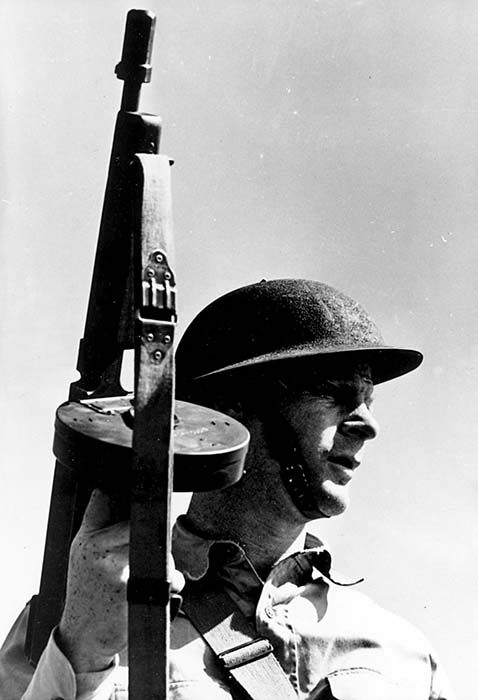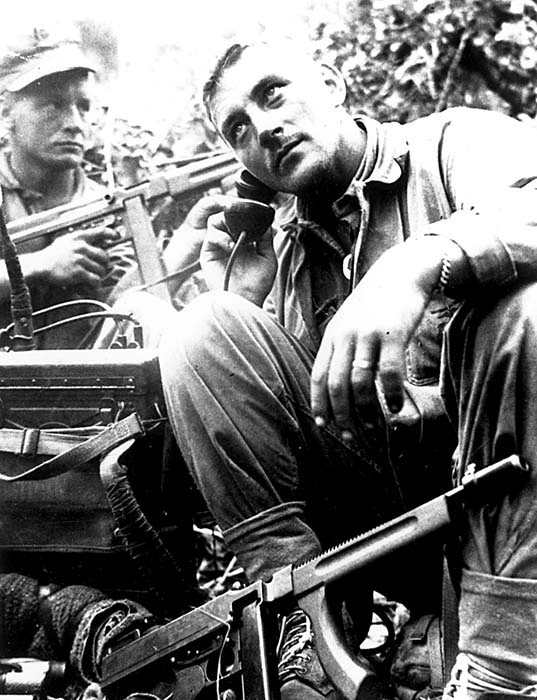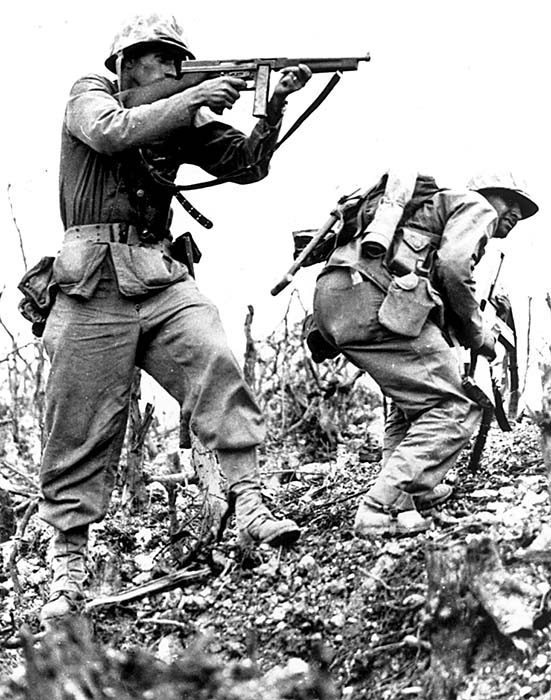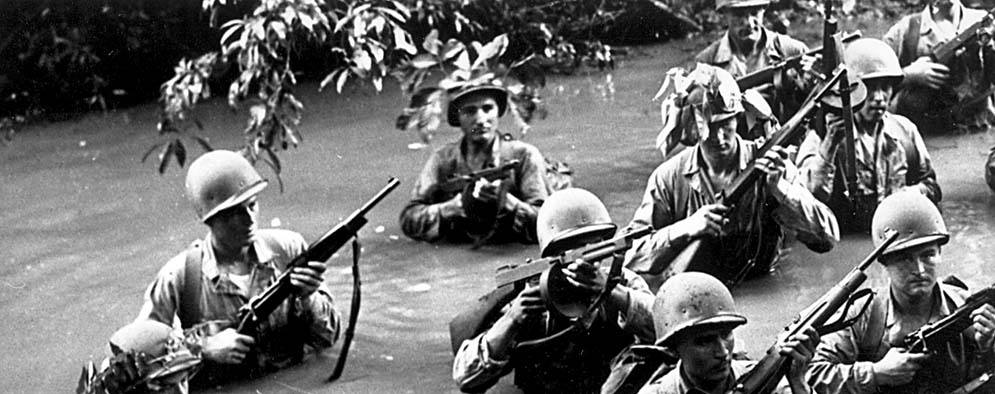Fort Clayton, Panama Canal Zone, 13 Jun 42. “Bushmasters” in jungle warfare training are careful to hold their weapons high as they cross a swollen stream. Note their interesting cut-down ’03 springfield rifles and drum-fed M1928A1 Thompsons. Credit: US Army Signal Corps/Center of Military History/Robert Bruce
By Robert Bruce
The high expenditure of .45-caliber rounds for the submachine (Tommy) gun was partly caused by the…infantrymen’s preference for the Tommy gun over the BAR. In contrast to the Marines on Guadalcanal, who swore by the BAR (and objected to the Tommy gun because it sounded like a Japanese weapon and drew friendly fire)….”
From The Ordnance Department: On Beachhead and Battlefront, L. Mayo, Office of the Chief of Military History, 1968, USGPO

Fort Riley, KS, Apr 42. This US Army mechanized cavalryman is armed with a M1928A1 Thompson Submachine Gun distinctively fitted with a 50 round drum magazine and Cutts compensator on the muzzle. Although quite impressive in the photo, this gun was overly complicated and soon replaced by the M1 and M1A1 models. Credit: Office of War Information/Library of Congress/Robert Bruce
Born as a “Trench Broom” for assault work in WWI, the legendary Thompson Submachine Gun is arguably America’s most famous military weapon of the 20th century. Indeed, the very name “sub-machine gun” didn’t exist until the Thompson came along. A favorite weapon of gangsters, G-Men, and commandos, General John T. Thompson’s finely crafted automatic firearm is known and respected from Chicago to China and all parts in between.
Although quite heavy, it adapted well to the very different tactics of fire and maneuver that characterized WW2 in the pacific. Compact and handy for armored vehicle crews and paratroopers, its rapid, hard-hitting firepower made it a good choice for use in the restricted terrain of jungles and also the house-to-house fighting that characterized the liberation of Manila and other cities.
The Thompson Goes to War
Although the first production models came out of the Colt factory in 1921, Thompson’s Auto Ordnance Company was not successful in selling more than a few hundred to the American armed forces or to any of our allies. However, when Germany invaded Poland in 1939, the French and British quickly placed orders for over 100,000 guns. America’s mobilization in 1941 brought orders for 300,000 more and “Lend Lease” programs of American aid to Russia and China got the production line humming around the clock.
Mass Production
By the end of 1941 the guns were in frantic full production at Auto Ordnance’s new plant in Bridgeport under contract to Savage Arms. These military model 1928A1 guns were a slight modification of the original 1921’s featuring a slower rate of fire, fixed rear sights, and a sturdy horizontal foregrip that was less likely to break in rough handling. Still too complex and expensive to make with desired efficiency, the demands of mass production and military necessity forced a reevaluation of the “Blish adhesion locking bolt system” that had characterized the gun from its inception.

Okinawa, 1945. Marine Corporal Tom McCauley monitors the radio while a buddy keeps his M1 Thompson ready to deal with any Japs in the vicinity. McCauley’s customized M1928A1 Thompson can be seen at his feet, equipped with a 30 round stick mag and curved wooden foregrip. Credit: USMC/National Archives/Robert Bruce
Savage engineers discarded the semi-mystical Blish lock and came up with the simple and reliable M1 model, standardized in April 1942. This gun had a straight blowback operation, feed by box magazine only, and a general elimination of frills such as barrel cooling fins and the Cutts compensator. Soon, the M1 was itself further simplified by elimination of the hammer and separate firing pin assembly, entering production just six months later as the M1A1.
This final version was the most commonly used model by soldiers and marines in the Pacific who particularly appreciated its rugged simplicity. Moving the cocking handle from the top to the right side helped with the always vexing problem of dirt and rain entry into the receiver, and putting a fixed firing pin on the face of the bolt reduced the gun’s mechanism to its bare essentials.
Banzai Charges
The Japanese Army and Naval Infantry most often encountered in the South Pacific were primarily armed with bolt-action rifles and supported by substantial numbers of light and heavy machine guns. Neither of their two standard submachine guns, chambered for the relatively weak 8mm Nambu pistol cartridge, were issued in significant quantity. Although Japanese tactics varied as widely as the terrain on which they fought, it is fair to characterize most of it as strongly emplaced defenses with sporadic but intense counterattacks, plus constant probing and infiltration.
Contemporary accounts of Tommy guns in jungle fighting reveal why the combination of a compact weapon with a high rate of fire and hard-hitting bullet was of such value. With firefights routinely taking place at 25 yards or closer in thickets of vines and tall grass, the 230 grain .45 caliber “steel bumblebees” pumped out by a Thompson would not be so easily deflected on their way to the target and would cause massive shock and blunt trauma on arrival. Contrast this with the Carbine’s puny 110 grain bullet for a better appreciation of the way a Thompson would, in the words of one Marine on Saipan, “put ‘em down hard, fast and forever.”
Often facing relentless human wave attacks in the fanatical “Banzai” charge so often resorted to by Japanese infantry, the Americans could count on their simple and reliable M1 and M1A1 Thompsons. Capable of emptying a 30 round magazine in less than 2.5 seconds, another could be immediately slammed in place and the grim job of piling up the bodies could continue in concert with the infantry company’s Garands, BARs, and machine guns.
Marauders and Chindits
Not surprisingly, the Thompson was often a favorite when the time came for a handful of men to go out on patrol. Although heavy as hell at some twelve pounds fully loaded, it was shorter and handier than an M1, harder hitting than a carbine, and could put out an even higher volume of short range fire than the BAR. These advantages, no doubt, proved decisive when running into a superior number of Japanese.
Much praise for the Thompson can also be found in accounts of the exploits of Brigadier General Frank Merrill’s regiment of commandos operating behind Japanese lines in the Burma campaign. Merrill’s Marauders, as they became known in press reports, were well equipped with a variety of infantry weapons, but many particularly favored their Tommy guns.
Hundreds of thousands of Lend-Lease Thompsons were also in the hands of our Chinese and British Commonwealth allies in the China-Burma India theater of war. Photographic evidence shows these mostly to be the early production M1928A1 guns with less reliability due to the top-mounted charging handle and the superfluous Blish lock. It is worthy of note that, while the .45 caliber guns were apparently appreciated by the Brits and Aussies, it didn’t take lot of persuasion later in the war to get most to swap their heavy Thompsons for the substantially lighter 9mm STEN and Owen submachineguns.

Okinawa, 1945. “Drawing a Bead” is the official caption of this dramatic photo of a 1st Marine Division Thompson gunner in action on Wanna Ridge with what is probably an M1A1 with 20 round mag. Close examination of the photo shows the gun firing (blurred bolt handle halfway down its receiver cut and a case in the air above his right shoulder). His buddy is armed with a BAR that – characteristically in most combat photos – has the bipod removed. Credit: USMC/National Archives/Robert Bruce
Interestingly, the Chinese have produced many homemade copies of both 1928 and M1/M1A1 Thompsons since WW2 and a lot turned up a few years later in Korea and then in the Vietnam War.
| This article first appeared in Small Arms Review V4N3 (December 2000) |











